Using the Work of an Expert in Forensic Accounting – FAIS No. 230 Guidelines and Best Practices
- Blog|Account & Audit|
- 12 Min Read
- By Taxmann
- |
- Last Updated on 23 September, 2024

"Using Experts in Forensic Accounting" refers to the process of engaging specialized professionals to assist in forensic investigations, particularly when complex, technical knowledge is required. FAIS No. 230 provides guidelines for identifying, selecting, and evaluating experts in various fields to support forensic accounting engagements. It ensures that professionals follow a structured approach to integrate expert knowledge, maintain responsibility for the final report, and uphold standards of diligence and accountability. This helps in gathering reliable evidence and forming well-informed conclusions in forensic cases.
Table of Contents
- Conceptual Overview
- Core Ideology of the Standard
- Practice Considerations
- Do’s and Don’ts
- Key Deliverables
- Summary
Check out Taxmann's Forensic Foresight | Case-Based Perspective on Forensic Accounting Standards which is a practical handbook for understanding and applying the Forensic Accounting and Investigation Standards (FAIS) issued by ICAI. The book serves as detailed guidance to professionals investigating the Financial Crime Landscape. It emphasises practical examples and provides analysis and tools for immediate professional use. This book includes in-depth explanations, real-world applications, actionable tools, global comparisons, and practical advice.
1. Conceptual Overview
Cases of an investigative nature are not always straightforward. Some cases are non-financial but require forensic accounting expertise. Likewise, there are forensic accounting cases that may require specialists from other domains. An engineer to measure silo tanks in an oil inventory leakage case or a valuation expert in a real estate fraud case are some scenarios that involve getting specialist reports to get an understanding. In recognition of this, standards such as FAIS No. 230 have been established to provide a guide for professionals when engaging external experts for various forensic cases. The need for a dedicated standard for engaging experts arises from their role in enhancing a professional’s ability to obtain reliable evidence, address complex issues, and reach informed conclusions.
The Standard, specifically focusing on “Using the Work of an Expert,” evaluates the needs for and availability of expertise so that professionals have enough guidance to identify when and which type of specialised knowledge is required for their engagements. Aspects of exercising authority in selecting the right expert, the significance of evaluating an expert’s credibility to guarantee that their contribution adds to the quality of professional’s work. The responsibilities involved in assessing the work performed by the expert and effectively integrating their findings into the professional’s report add value to the overall engagement.
Importantly, despite delegating certain tasks to experts, the professional retains ultimate responsibility for the work performed. Professionals not only have to choose their experts wisely but also closely oversee their contributions so the entirety of the work aligns with the required standards and objectives. The standard sees that the integration of expert knowledge is conducted with diligence, accountability, and commitment as many times, the final outcome of the engagement is very much dependent on the role of the expert and their report.
2. Core Ideology of the Standard

The standard’s focus or value for the professional is concerned around two specific questions.
- What specific expertise is needed for their engagement?
- Are experts with the required skills available and beneficial to the engagement?
The Professional’s goal here is to gather evidence that is both relevant to the case at hand and reliable enough to be used confidently in their work. However, it is the professionals who have the responsibility and authority to decide which expert to engage for their needs. The decision about which expert to choose or who is best suited to provide the necessary assistance. The decision involves carefully evaluating potential experts to determine their credibility, like reviewing their qualifications, experience, and reputation in the field.
Regarding the engagement of an expert, there are three critical stages that a professional needs to understand: The preparation phase or the Pre-Engagement of an expert; the Operational phase or the Engagement phase; and the Closure phase or Post-Engagement. Each stage encompasses specific actions and considerations for integrating an expert’s work into professional engagements.
2.1 Pre-Engagement of the Expert
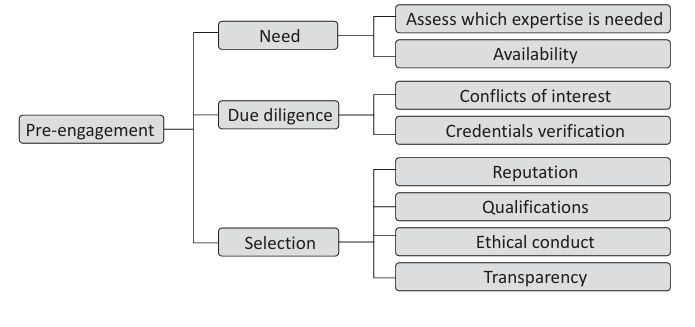
The initial step in preparing to engage an expert for a forensic accounting or investigation task involves carefully assessing the case’s requirements to determine the specific expertise needed.
Consider the case of the medical start-up Theranos. This Pharmaceutical industry was involved in high-end technology to revolutionise blood tests with numerous claims. It was one of the costliest fraud scams as a whistleblower complaint toppled the claims, revealing the most highly technical lab malpractices. The company was entangled with financial manipulations. Here, it would require the involvement of experts from the pharmaceutical industry and lab technicians with specific knowledge of blood testing technologies.
Identifying the gap between the team’s existing expertise and the specialised knowledge required is the next course of action.
Due diligence is also part of the pre-engagement process. It ensures the chosen expert’s independence, securing against any conflicts of interest that could undermine the investment’s integrity. The experts’ qualifications and professional standing are verified through an evaluation of their published works, previous case involvement, and discussions within professional circles. A vetting process confirms the expert’s ability to contribute valuable insights to the investigation. At times, the expert might be qualified but lacks an understanding of the case’s specifics. The Professional must evaluate the merits and decide.
The selection of the expert also depends upon their reputation, qualifications, and ethical conduct. Then, a written confirmation or declaration from the expert is obtained, outlining their understanding of the engagement’s scope, their acknowledgement of any potential conflicts of interest, and their commitment to upholding ethical standards throughout their involvement. The confirmation letter can also be accompanied by a non-disclosure agreement. Professionals must note that these are not merely procedural but foundational steps to ensure transparency. These pre-engagement documents establish a clear framework for the expert’s contribution and any dispute that may arise after the work completion.
2.2 Engagement
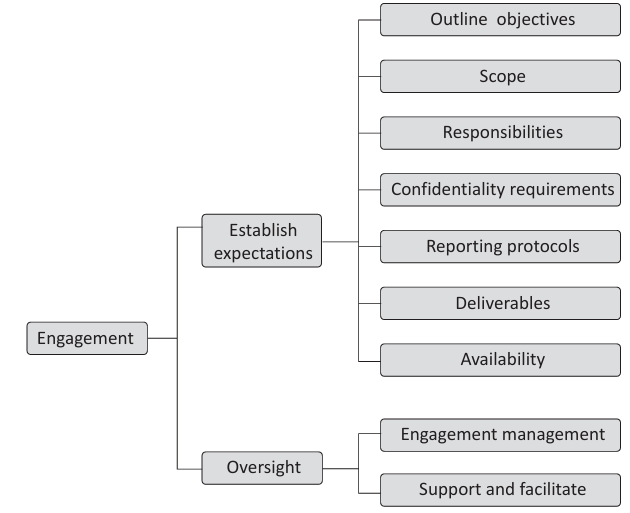
Once the preparatory phase of identifying and vetting an expert is complete, the engagement phase marks the transition into active collaboration. The basis of effective engagement lies in the precise communication of expectations. A few factors to consider are articulating the objectives, scope, responsibilities, confidentiality requirements, reporting protocols, and expected deliverables. For instance, in a case requiring analysis of cybersecurity breaches within a financial institution, detailing the specific areas of focus, such as network security or transaction anomalies, sets clear parameters for the investigation. The expert’s efforts can be directed toward areas of greatest impact. If there are budget issues, it is preferable to direct the most specific area of work to the expert. As specified in the pre-engagement phase, establishing confidentiality requirements upfront protects sensitive information. The inclusion of confidentiality terms can be part of either the pre-engagement or the active engagement phase, depending on the professional practice and case complexity. Having clear protocols for reporting helps in generating coherent and actionable findings.
A formal agreement embodies these details and serves as a contractual foundation for the engagement. It specifies the nature, scope, objectives, roles, and responsibilities of both parties, as well as communication protocols and how changes to deliverables will be managed. Such an agreement may also include specific pointers, for example, provisions for interim reports or presentations, enabling ongoing review and adjustment of the investigative focus as new information emerges.
Regular monitoring and evaluation of the expert’s progress maintain alignment of the expert’s work with the established objectives and scope. This ensures adherence to the agreed-upon parameters and timelines. In investigations, such as those involving money laundering fraud schemes, periodic assessments allow for the recalibration of investigative strategies based on emerging data or findings.
Providing the expert with necessary support and information, such as granting access to proprietary data systems, offering insights into industry-specific practices, or arranging discussions with key personnel, speeds up the process.
2.3 Post-Engagement
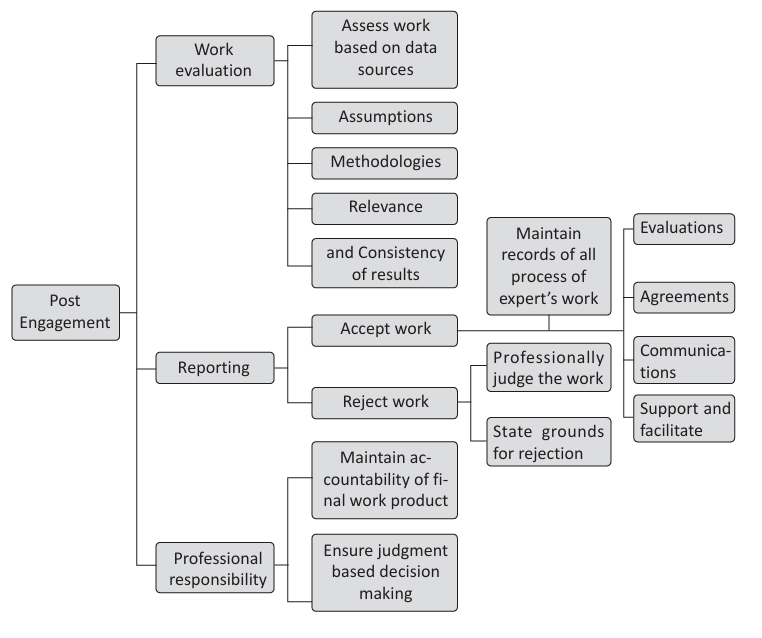
The post-engagement process revolves around reflection, assessment, and decision-making. Just because it is an expert doesn’t mean that the report should be accepted without question. It should also go through scrutiny. The post-engagement phase is a thorough evaluation of the expert’s work involving a review based on several criteria, including the sources of data utilised, the assumptions made, the methodologies applied, and the overall relevance and consistency of the findings. Suppose the engagement involved a valuation expert in a merger and acquisition case; their valuation models, data sources for market comparison, and underlying assumptions would be examined for accuracy and alignment with industry standards. Evaluation not only validates the integrity of the expert’s contributions but also ensures that the conclusions drawn are robust and defensible.
If the Professional disagrees with the expert’s report, they must provide supporting reasons. The fact about disagreement and rejection of the finding may be disclosed in the final report. It is ideal to disclose but the call is on the Professional. Disclosing it increases the report’s credibility and presents it as balanced and unbiased when contested in a court of law.
Apparently, the FAI standard also addresses disagreements. While not uncommon, disagreements over the expert’s findings imposes a structured approach to resolution. Some of the means of corroborating the results are:
- Discussions to refine misunderstandings,
- Further review of the methodologies used,
- Additional procedures to verify contentious findings
When discrepancies remain unresolved, engaging another expert for a second opinion might be necessary.
Finally, detailed records of all evaluations, agreements, communications, and decision-making processes must be maintained as a reference for resolving potential disputes and aiding the seamless integration of the expert’s contributions into the final report. However, the decision to include the expert’s findings in the final FAI report is a matter of professional judgment. Determination based on various factors such as relevance, accuracy, and impact of the expert’s work on the engagement’s objectives. Including these findings can influence the conclusions and recommendations presented in the report.
As a result, the professional retains the final responsibility for the quality and integrity of the work performed.
2.4 Ownership of the Experts’ Working Papers
Typically, the expert retains ownership of their working papers, but professionals may have conditional rights to access them. It is recommended to specify the ownership terms of the experts’ working papers within clauses in the experts’ engagement letter.
Include terms like:
- Access terms such as who can access, under what conditions, and what
parts of the working papers. - About how and when can the experts’ working papers be produced before the competent authority.
- Confidentiality terms related to expert reports as well as working papers.
- Handover procedures for the working papers upon completion.
It is suggested that the Professional maintains a trail of all communication and modifications such as significant interactions, documentation related to expert engagement, major decisions, etc. Ensure secure storage of records to prevent unauthorised access or losses.
Defining the period for which these documents should be kept is suggested for accountability purposes and revisiting it for various engagement needs.
3. Practice Considerations
3.1 Real-world Application
Refer to the Peril Ltd. case where the Senior Professional identifies the need for a handwriting expert on Page No. 283 under ‘Specialist Onboard.’
3.2 Caselets
Caselet 24: Disagreement with an Archaeologist’s Assumptions
A development project’s value assessment centres on the historical importance of an archaeological site. Upon evaluating the expert’s work, the Forensic professional firm finds the archaeologist’s assumptions overly optimistic by inflating cost projections.
The firm immediately met with the experts’ team. They decided to reevaluate assumptions against historical data. Further adjustments of assumptions were made for a balanced evaluation. As a result, a more viable project cost estimation was arrived at.
Caselet 25: Collaboration with a Scientist for Space Exploration Ventures
A forensic professional firm was consulted to evaluate the reason for a high project cost overrun in a space exploration project. The scope was to accurately assess the returns and risks associated with the space missions.
The firm engaged a space scientist outside the organisation with expertise in space mission costs and potential revenue streams from space exploration.
The expert conducted a detailed analysis. Some of these are,
- Previous space missions,
- costs of similar missions
- potential commercialisation of space technologies
- analysis of ROI.
The expert presented a comprehensive project model reflecting realistic space exploration investment outcomes. After using the report as a base, the forensic professional firm conducted further investigations.
Caselet 26: Expectation Alignment Issues
A forensic professional engagement required an in-depth review of the renewable energy sector. The firm expected specifics on the efficiency rate of solar panels in different environmental conditions. They engaged an industry expert.
However, the expert gave a broad, simple overview of the system in place. Mismatch in the expectations led to difficulties in translating the expert’s findings into their forensic report. The firm then decided to communicate a clear scope of work expected in writing with the expert.
Caselet 27: Breach of Confidentiality
An expert in the medical field also had a large following on social media. The person was hired to provide expertise in a forensic case. The task was to analyse care standards in a sensitive medical negligence case. Even though there were strict confidentiality agreements in place, the expert accidentally revealed the case details on social media live, believing that the information shared was generic enough to be not identifiable. There was a confidentiality breach because the details were so exact that they could be traced back to the original instance.
The case indicates how important confidentiality agreements are, particularly in informal situations.
3.3 Case Study
Music Expert Engagement in Copyright Dispute
In a notable copyright infringement dispute, the TR Record Manufacturing Co. Ltd., found itself entangled in a legal battle with Mr. Melo. TR Record was a music company, and Mr. Melo, a celebrated film composer. The contention was centred around the ownership of copyrights for musical works in feature films produced between 1975 and 1982 by the composer. The music company engaged Dare & Associates, a forensic professional firm, to resolve this dispute and accurately calculate the value of the copyrighted works.
The forensic firm understood that the case involved two distinct areas: the copyright law and the music industry. Therefore, the firm appointed experts in these industries. They were tasked with evaluating the legal and industry-specific aspects of the case to provide a well-rounded analysis.
To avoid conflicts of interest and maintain the integrity of the case, the team employed strategic measures in selecting the music expert so that the case would be impartial and confidential.
- They chose an academician affiliated with a music school different from that of the composer’s own established schools and studios for a degree of separation.
- Information about the celebrated composer for whom the engagement was being conducted was shared strictly on a need-to-know basis with the music expert.
The Expert Analysis involved:
- Evaluation of Copyright laws: The copyright law expert reviewed the Copyright Act’s provisions to delineate the definitions of “author” and “owner” and to clarify the conditions under which copyright ownership and assignment are determined.
- Music industry insights: The music industry expert provided an in-depth analysis of the standard practices regarding the assignment of work, payment, and rights and how these practices might influence the interpretation of ownership and authorship in the context of cinematograph films.
- Valuation of copyrighted works: The appointed experts assisted the forensic accounting team in calculating the potential value of the copyrighted musical works, taking into consideration both the legal framework and industry norms.
A detailed plan was established as to how to approach the legal analysis and valuation process with all relevant aspects of copyright law and music industry practices. The experts were relieved after sharing insights and data under strict confidentiality to preserve sensitive information. Afterwards, the firm compiled and corroborated all the information and concluded the case.
The case study shows how successful collaboration between a forensic professional firm and external experts in resolving a copyright dispute. The engagement of these experts, in line with the guidelines of the Standard, proves to be useful in such specialised domains. The diverse nature of the forensic accounting field is demonstrated here.
4. Do’s and Don’ts
4.1 Do’s
- Clarify the objectives of the assignment. Even with a clear scope, there can be a mismatch in expectations between the experts.
- Ensure adherence to confidentiality agreements. Include consequences of informal communication as well.
- Have a flexible timeline and budget when engaging with an expert, as there can be issues with availability, cost and timelines.
- Have in writing the terms about ownership of work papers of the expert.
4.2 Don’ts
- Don’t expect a perfect report from the expert. Sometimes, the result can be subpar or unsuitable for the overall forensic report.
- Don’t assume 100% smooth communication with the expert. There can be friction due to working style, leading to delays and communication breakdowns. Have patience.
- Don’t ignore quality checks and take expert reports for granted. Review and validate information.
- Don’t avoid mentioning the disagreed expert report in the final forensic report. State the facts and reasons for disagreement for credibility.
5. Key Deliverables
5.1 Checklist to Bridge Expert Report and Forensic Report
When an expert produces a report, it may be in formats different from that of the professional forensic report. It may be highly technical to be able to comprehend and reduce the usability. Professionals can maintain a list of procedures or have a checklist to ensure specific factors are included by the expert along with the report.
5.2 Checklist
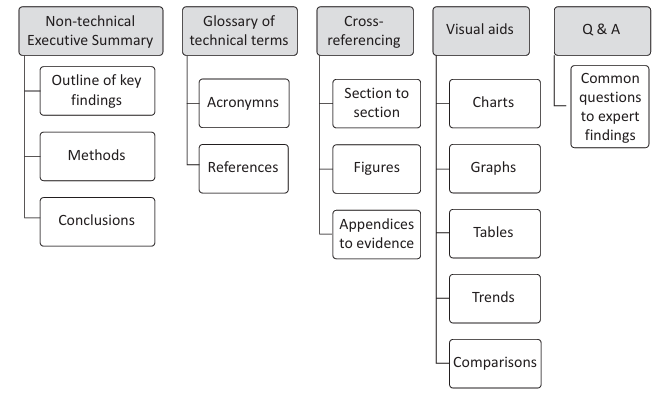
6. Summary
The Standard on ‘Using the work of an expert’ guides about on boarding a specialist for technical cases. It guides on how to effectively engage and utilise experts within their engagements for forensic professionals. It begins with an approach to identifying the need for an expert, evaluating the expertise required for the engagement and selecting criteria. It mandates thorough due diligence to confirm the expert’s independence to avoid any conflicts of interest.
Apart from confidentiality and reporting protocols, formal agreements that details the scope, responsibilities, deliverables, timelines, etc., are some of the main factors to consider when engaging an expert. The standard also suggests evaluation of the expert’s work post-completion before integrating it into the final report of the professionals. Ultimately, the professional becomes responsible for maintaining the quality and applying professional judgment right from the selection, engagement and application of the expert and his reports in the FAI engagement.
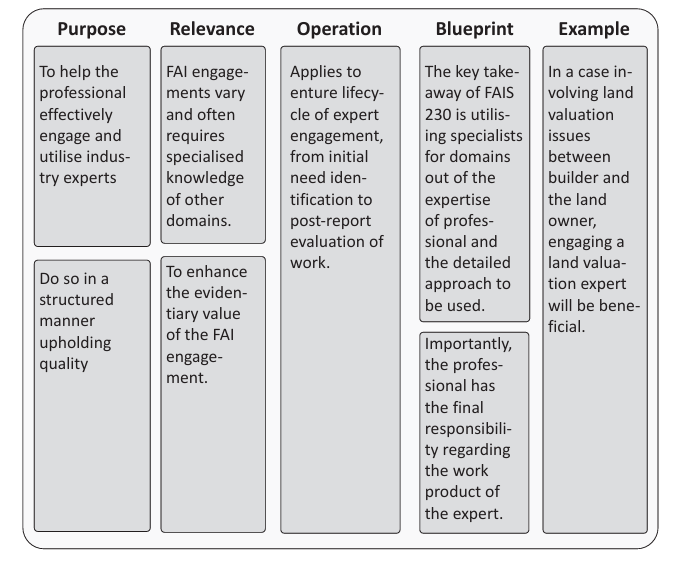
Disclaimer: The content/information published on the website is only for general information of the user and shall not be construed as legal advice. While the Taxmann has exercised reasonable efforts to ensure the veracity of information/content published, Taxmann shall be under no liability in any manner whatsoever for incorrect information, if any.




 CA | CS | CMA
CA | CS | CMA
